**Historial API Evolution**
As per the documented history, the occurrence of web APIs transpired towards the end of 1990 with the launch of Salesforces sales automation solution. At that point in time, it was an open resource, awarded to everyone.
Salesforces automation tool was XML-driven and the format used for interchanging the data for this tool later got acknowledged as standard SOAP API. It featured message format specifications and encoding-specific rules related to allowing or disallowing requests.
Most of the developers need to tackle SOAP for API development and creation. They also need to bring a manual XML document into action, along with RPC. Afterward, developers need to explain endpoints for API and POST the SOAP suite to that end-point. Not only does it account for the birth of API, but it was also the beginning SaaS concept.
It was 2004 when the world witnessed a massive change in APIs course of action with the emergence of platforms like eBay, Amazon, and eBay as they all invested efforts in evolving the APIs. These three platforms change the communication with the web and the surrounding world. The updated API version wasnt connected to the commercial aspects of a solution. Rather, they started adding value to businesses.
Some of the key events that shaped modern-world API involve the launching of Flicker and Facebooks APIs. Flicker developed a platform to store the digital images over cloud and the platform was developed using APIs that supported image sharing across diverse platforms and integrating photo-sharing facility new services.
By 2008, API was updated to an extent that they can operate on their own and can handle mammoth interconnected information. Twilio showed all of us that an API is all you need to handle the whole product. They launched an API that can connect telephones for calls and texts.
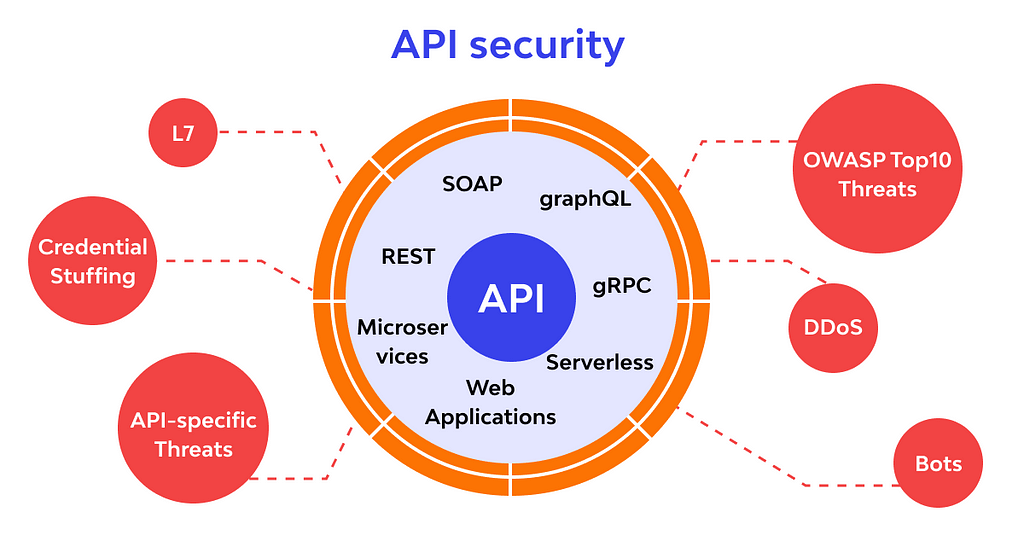
### What is API?
For beginners, API refers to the Application Programming Interface designed for effortless communication between two different applications. This is why its often referred to as the middle person for the application. While we discuss API, mentioning API security is essential, as its what protects the integrity of the apps, owned and used by the users.
Lets understand the API meaning in detail. Todays world is driven by IoT or the Internet of Things (IoT) wherein computing is integrated into day-to-day objects and operations. A real-life example of IoT implementation is using an app that can connect the phone with your refrigerator and allows you to operate from anywhere. Using that app, one can operate the refrigerator remotely, can find out whats inside it, and even reduce the temperature.
For developers, API is a great tool to use while exchanging information between microservices and containers and fast-paced communication. Just as integration and interconnectivity are crucial for application development, API drives and enhances application designing.
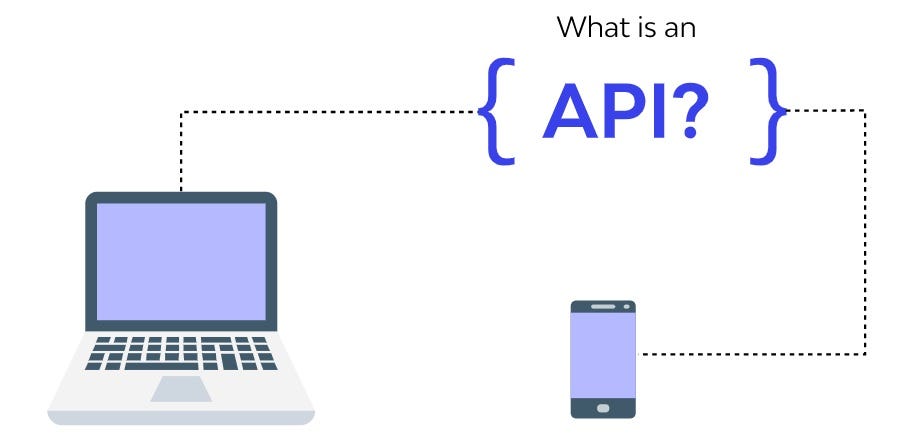
**API Taken the Internet by Storm**
APIs were functional as proprietary protocols even before Before the world got to know WWW and the internet. They are playing a crucial part of working wherever distributed networks are used for a restricted area, purpose, or organization. During the pre and post-internet era, APIs served the same purpose and made computing communication possible.
When Web 2.0 breaks into the world, web-based tools become more than assistance to humans. They acted like lone warriors that could handle all the operations on their own. During this phase, REST rose to fame. It is used to explain API interfaces that are used later to architect the actual applications.
The credit to offer REpresentational State Transfer Framework (famously-known as REST) to the world goes to Roy Fielding, who suggested using such a framework in his Ph. D. work in the year 2000. It soon became a norm in the community of development experts and paved the path for OpenAPI.
In the times of Web 3.0, APIs are playing a crucial role in communication between IoT and AI-driven devices. The customary request-response paradigm of API had to be modified as event-driven so that APIs involvement becomes more intensified.
### API use cases
APIs are widely used in the world of app and web app development. They are the foundational elements of applications as they allow information exchange effortlessly. Some of the most customary and crucial use cases of API are as under:
* **Single Page Applications (SPA)**
Using the REST API, the development of SPA or Single Page Application is accelerated. SPA apps make website content optimization possible and fits all the content on one page and grants an amazing user experience.
For the development of such applications, predefined CSS, JavaScript, and HTML files are used to begin the web server communication.
Here, the REST framework is used for server-side communication while a particular kind of framework is deployed for client-side information exchange.
The commonly used REST API framework for SPA development in Jersey. Nancy Fx, Express Js, and ASP.Net Web API. The use of REST API for SPA development promotes improved scaling as its a stateless API framework and is not bothered by the use of one or many servers by the client for each request. This reduces the efforts invested to scale the application and eliminates the need of accessing the certain resource.
Other than REST API documentation, nothing binds clients and servers used in SPA development and makes them work as distinct beings. This independence promotes flexible development, testing, and deployment.
On the other hand, if a dynamic web pages framework is used, no such notable freedom is granted to the developers.
* **Public API, enterprise B2B**
For a long time, phone calls, fax, and email have served as key communication means for B2B operations. However, the gained technical momentum has promoted the use of integrations IoT-based information exchange. Restful API is playing a crucial role in automating enterprise B2B communication.
From customers point of view, releasing public APIs allows businesses to create a consumer-oriented application that makes communication with the outside world attain maximum utility.
The derived sluggishness of B2B processes can be curbed with the use of public APIs as they make business processes de-coupling possible and augment the machine-based interoperability. Public API allows B2B customers to expand the user-based, when the need for this action arises, without increasing the costing burden on the enterprise.
* **Private API, internal API services**
Using the private API, B2B customers trim down the time-to-market and launch new applications and tools quickly while causing no bottlenecks for existing workflows. When it comes to managing internal workflow, private APIs make figuring out the areas where there is a need for restructuring and modernization to make the enterprise composable.
The composable business model is an inventive process of breaking the complex functions into miniature pieces for easy handling. It promotes the strategic use of resources. Private APIs support internal communication at every level and make it efficient.
Collaboration and information exchange becomes swift and secure when done using private APIs.
Internal APIs have made business intelligence analytics more precise as it provides precise details on system parts that might cause operational hindrance and can level up the response time.
* **Service Mesh**
It is a component of the infrastructure layer that is highly configurable and is of low latency. Its used for handling the internal communication that happens at a large scale on the network-based structure. Use of these meshes warrants the swift, secure, and dependable information exchange related to the containerized and ephemeral application.
APIs are used for information exchange in the service mesh. As the data plane of a mesh makes contact with every possible packet or request that goes through the system, things become cumbersome.
The use of APIs like Universal Data Plane and xDS makes the job easier and allows swift operations related to checking system health, monitoring its performance, routing the incoming or outcoming requests, load sharing for balancing the burden of the system, service discovery, and user authorization for preventing malfunctioning.
* **Mobile Backends**
An emerging service delivery model, mobile backend is used commonly for mobile-optimized solution development. Offered as MBaaS or Mobile Backend as a Service, this development model grants freedom to the developers to maintain the servers and server-related tools. An ideal MBaaS platform endows developers with assorted facilities including user management, push notifications, and social login plugins.
MBaaS sources use flexible SDKs to leverage the endpoint connectivity for API. By doing so, MBaaS makes the development of frontend applications for Android and iOS OS using high-end technology like Flutter, Unity, Iconic, and ReactNative.
The use of MBaaS platform APIs allows developers to promote automation at fronts like workflow management, notification updates, and tasks planning.
Additionally, an inventive API encourages the generation of an application layer that is used for seamless information exchange between various systems and services used. Developers can contrive need-based services for newly added user clusters.
* **IoT (Internet of Things)**
IoT is one of the fastest-growing tech today, and is likely to back more than 80% of tools and software in coming times. Development of IoT devices/tools makes seamless with the use of APIs as they offer pre-defined communication routines and protocols for development.
As IoT devices need to connect to customers or other network users devices to complete the information exchange done, using API ensures exposed information is secure, goes to the exact destination and gets along well other peer devices. Developers can create context-based applications competent enough to interact with the outside world without using the UI.
REST API is the most universally used API for IoT devices production and it proffers communication exchange over internet protocols. As IoT is driven by the internet, REST API encourages information exchange over the internet. Additionally, REST API allows developers to implement user authentication and permission-granting strategies.
### API for different folks look really different
In the previous section, we provided a general overview of API to you. Its usage is so wide and diverse that it works differently for different purposes.
**Back-end developer:**
* **Framework: **A well-structured plan or strategy that defines how operations and processes will work;
* ?**Specification: **A Swagger-based documentation that describes the functioning of REST or [OpenAPI](). For example, a document explaining the technicalities of circuit version 3, a clarification on everything related to Geo PC, a GraphQL schema that is different from the default version, or protobuf.
* ?**Data and Business Logic:** It was impossible to imagine operating without HTML markup, but not anymore. Now, we can split data, logic and markup during the development today. Back-end developers prefer separating data and logic between clients (e.g. mobile app or browser). This helps them reuse and repurpose their code or data, e.g. single page applications and mobile apps can use the same data. Similarly, business integration, especially custom integrations, can be handled due to this.
* ?**Unified mobile, web and integration backends** to improve and simplify the synchronization process.
**DevOps:**
* **Specification meets Production:** For example, if an endpoint returns 502 very often, shouldnt you truy to find the reason and mitigate it? Same has to be done for other issues and needs.
* ?**Scaling:** If an endpoint requires scaling to solve 504 Error, it is essential to find out the responsible microservice, optimal process, and orientation of the problem (e.g., REST API info GraphQL)
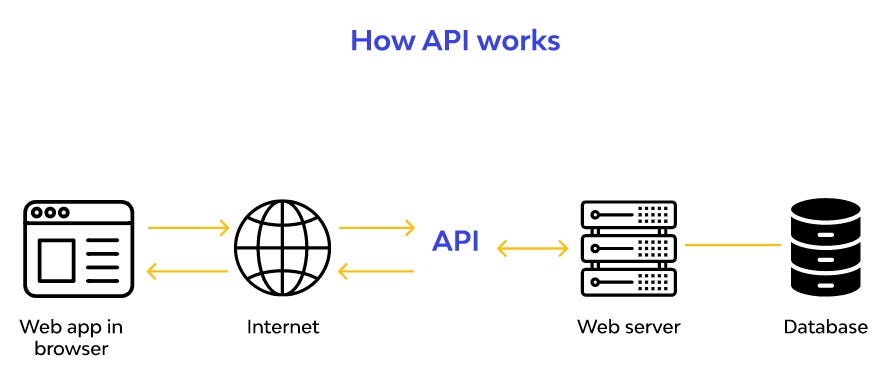
**Security:**
* **New protocols:** My firewalls, scanners, and other old tools stopped working on upgrading. What to do?!
* **East-west security:** The communication within my network is not monitored well?!
* New security, networking or other IT compliance
**Why is API security important?**
As said previously, API and API security go hand in hand. Paying attention to the API security is crucial, as APIS with poor API security are prone to be attacked, hacked, or exposed. APIs are mainly used for exchanging information, connecting services, and transferring data, and falling into the nippers of data breaches leads to major losses for businesses.
Depending upon the vitality and significance of data/information exchanged by APIs, businesses can adopt diverse API security approaches. For instance, APIs that are used to connect to any of the third-party applications, like in the above-mentioned example, need to be accessed for their ability to funnel data back to the internet. You wont be worried if someone figures out whats stored in your fridge. But, if an API of the same app is tracking your location then its high time to fix it.?
### API Authentication Methods
The task of verifying users identity is imperative as it keeps ill-usage of API and verifies user authenticity before granting him the access to the stored information kept at bay. It involves verifying the identity of someone who tries to view or edit the API resources, allowing only authenticated users for the same.
1. **Host-based authentication**
This process comprises verifying the host or server so that only the verified users can access resources deployed on the servers. It doesnt demand any key or other means to initiate the process. However, the server should be competent to validate the login keys beforehand to keep the incidents of DNS spoofing, routing spoofing, and IP spoofing under control.
In the process and manner, its very much similar to RSA.
The argument used here is either yes or no. By default, no argument is set. The host-based verification of users can be done by an administrator by creating a private key for the local host or extracting the public key used for the localhost.
**2. Basic authentication**
One of the most straightforward API identity-confirmation schemes, this method is crafted using HTTP protocol and process as the client dispatches an HTTP request with a pre-built header for verification of authenticity and demanding credentials like accounts password and username. This basic check is done in a browser-powered environment.
Being supported by every possible browser and server makes basic identity-confirmation the most common one. The credential details are shared over the network in the form of cleartext and are encoded using base64.
It is functional over proxy servers and grants access to resources not hosted on IIS servers. As it fails to add encryption, not much security can be expected out of it. Also, its more prone to replay attacks.
**3. OAuth**
OAuth is the open method of identity confirmation. It is a customary API authenticity-verification technique that covers users identity verification and defining authorization criteria. Th protocol is used widely for allowing applications to interact with servers, storing API.
It requires asking for a token when someone tries logging into the system. The token serves here as the means of verifying and approving the user identity. The person/request-creator has to forward the request to accessing the rersouce to the authentication server. Based on the quality and result of identity-verification, the server can accept or reject the request.
OAuth is safer and more secure than other processes making it the first choice for many. The three key ingredients of OAuth are OAuth provider, Google and Facebook are the common ones, OAuth Client, refers to the information-owing website/page, and owner, denotes the user making an access request.
**4. OAuth 2.0**
A widely used protocol of API access management, OAuth 2.0 is an updated version of OAuth. Its functioning involves keeping the API client access limited by using HTTP services for the cleint application enabling. The key HTTP services needed for this sort of protocol are GitHub and Facebook. It takes the help of a code for identity-verification and doesnt ask for user credentials.
The three factors involved in OAuth 2.0 are the user, who is possessing the data to which the API wants the view or edit permission, the application, and the API.
Using this method for identity confirmation, its easy to interpret user data using different resources. It can be deployed for the verification and approval of web-based, mobile-based, and desktop-based applications/devices.
**5. SAML**
SAML stands for Security Assertion Markup Language and is a standard API process for identity confirmation using single-sign-on technology. It denotes confirming the user as per the provided details. Once the process completes and the user is verified, access to assorted applications/resources is granted. Presently, its SAML 20 version is running. Its very much similar to the ID. Only user identity assessment is done with its help.
**What Does API Security Entail?**
APIs, related to the app that you own, can only be controlled. This is why API security is focused on securing APIs that are exposed to a user, directly or indirectly. APIs, offered by other parties, that a user consumes are not a prime priority of API security as valuable insights related to such APIs can be gained by detailed analysis of outgoing API traffic.
One another key point to note here is that API security practice implementation involves multiple teams and systems. Network security principles like throttling, rate limiting, along with key data security concepts like identity-based security and analytics are a part of API security.
Access ControlRate LimitingOAuth authorization/resource serverRate Limits, quotasAccess rules definition and enforcementSpike protectionConsent management and enforcement
Content ValidationMonitoring and AnalyticsInput/output content validationAI-based anomaly detectionSchema, pattern rulesAPI call sequence checksSignature-based threat detectionDecoysGeo-fencing and geo-velocity checks
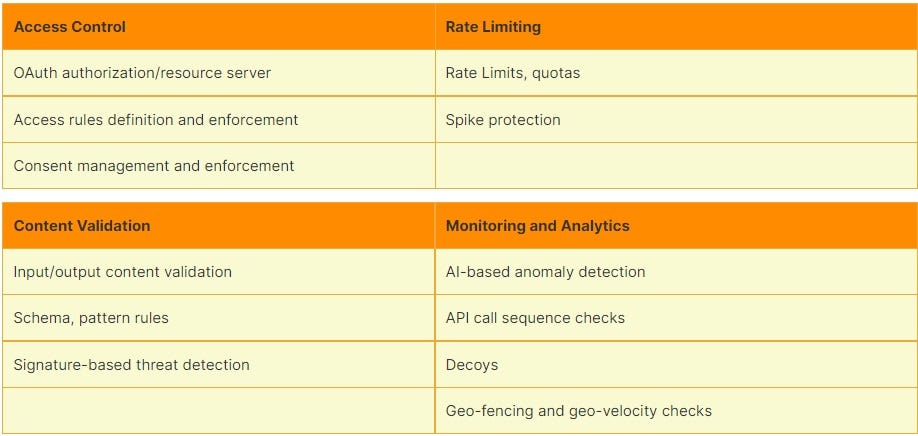
### API Protocols
Based on the requirements, APIs can be used in various forms and styles. The chosen API style ([REST](), [SOAP](), [GraphQL](), [gRPC](), Websocet or Webhooks) decides how API security should be applied and implemented. Before web APIs came into being, the key API style uses were SOAP Web Services. In the era of service-oriented architecture WS from 20002010, XML was used widely.
**The SOAP**
SOAP is an XML-based messaging/communication protocol and refers to Simple Object Access Protocol. It is used widely for information exchanged between computers.
This protocol can extend HTTP and offers data transport means for web services. Using this protocol, one can easily exchange all-inclusive documents or call for a remote procedure.
Though SOAP can be used in various messaging systems, its key focus is on remote procedure calls transferred via HTTP. Its distinct from other frameworks like CORB, DCOM, and JAVA RMI in one aspect the whole message is penned down in XML in SOAP. It makes SOAP protocol unique and language-independent.
**REST**
Introduced by Roy Fielding, Representational State Transfer or REST is HTTP protocol-based web standard architecture revolving around the combined and interrelated resources. All the resources, used by REST, are accessed only using HTTP standardized methods.
For each HTTP request to process, REST uses four kinds of verbs: GET, POST, PUT, and DELETE.
APIs, functioning via HTTP Requests, use RESTful architectures. For developers, its the easiest possible tool for comprehending the API functions and behavior. Its usage makes API architecture much more convenient to maintain and scale. It makes APIs accessible for both internal and external developers.
**gRPC**
gRPC is an open-source, cutting-edge, and high performing framework designed to evolve the old-school Remote Procedure Call or RPC protocol. It is majorly used to streamline the communication and messaging procedure of client and back-end services. It uses [HTTP/2]() for its transport protocol, which is a binary framing protocol.
gRPC is utterly lightweight and is more than 8 times quicker than JSON. To accomplish the job, gRPC calls an open-source technology, Protocol Buffers. Using its help, gRPC uses a very proficient and platform-neutral serialization format for structured messages. In API, the use of gRPC allows developers to figure out which procedure should call for and assess the parameter values.
**Webhooks**
Webhook is an auto-generated message sent from one to another application. In other words, its used for establishing communication between two software. They are used for sending/extracting real-time updates. In situations where API use will waste time and resources or there are no constant updates, its wise to use webhooks over API.
As webhooks contain crucial information and transfer it to the third-party servers, API security practices like performing basic HTTP authentication procedures and TLS authentication are also implemented during the use of webhooks.
**WebSocket**
WebSocket is a two-way communication protocol designed to offer fullfledged communication channels between the clients and the servers. Here, the communication happened at both ends at the same time. The limitations of HTTP protocol can be easily curbed by this protocol.
It starts as HTTP requests and responses that the client uses to create a WebSocket connection. Server responses to that request. After the initial communication connection is established, both the clients and the server are allowed to use the current TCP/IP connection. Data/information flows over this connection via a fundamental framed message protocol.
**XML-RPC**
XML- RPC is a resource making WordPress and other systems communicate with each other by standardizing the communication process. It uses HTTP as a means of transport and XML as an encoding process. It existed before WordPress and was a part of the b2 blogging tool.
The at-work code is warehoused in a file named xmlrpc.php. This file is located in the websites root directory. It comes as a default option in WordPress 3.5 version and makes its mobile app interact with the web-based WordPress installation seamlessly.
With each access request, authentication details are shared by xmlrpc.php,making the odds for brute force attacks and DDoS attacks higher. The API used for XML-RPC needs to embrace robust API security practices for the same reasons.**?**
**JSONRPC**
For beginners. JSON-RPC is an ultra-light RPC protocol used for APIs playing a part in Ethereum Blockchain-based software/application development. It holds the ability to explain multiple data structures and rules that dictates their processing. This protocol can be consumed again and again over the same sockets. JSON (RFC 4627) is used as a basic data format in this protocol.
**MQTT**
MQTT is an OASISsanctioned message protocol widely used in IoT devices and tools development. It is amazingly lightweight and makes information exchange possible over HTTP. Its scalability empowers developers to use it on millions of devices at a time. API security is at an all-time high while this protocol is functional as it makes message encryption possible. TLS and authentication can be applied easily.
**AMQP**
Advanced Message Queuing Protocol or as we know it, AMQP is an open protocol dictating the message providers course of action. It is applied at the application layer and is used widely in the creation of interoperable systems.
The implementation of this protocol is binary and can bolster various message-oriented middleware communication with 100 % surety of message delivery. APIs, processed using this protocol, are bound to reach their destined destination.
**XMPP**
It is a bunch of viable free-source technologies used for the development of multi-party collaboration, instant messaging, multi-party chatting and video calling, and lightweight middleware. PHP, MySQL, Apache, and Perl are the four key components of XMPP.
**CoAP**
The API used for IoT devices needs to be backed by CoAP, a standard API security protocol. It stands for Constrained Application Protocol and is an IETF standard as defined by RFC 7252. The best option for securing simple microcontroller nodes, CoA can support communication over LPWAN. Its functional in the TCP/IP stack layers and asks the help of UDP. UDP works as the fundamental transport protocol here.
### API Security for Cloud, On-premises and Hybrid Deployments
The current advancements in the technology areas like cloud services, integrated platforms, and API gateways have granted APIs providers the ability to secure the API in multiple ways. The type of technology stack picked for building the APIs has a direct impact on the procedure used for securing the APIs.
For instance, a large organization might be using multiple applications with their own APIs. As organizations merge all these applications, various API silos or stacks are created. The API security requirements related to one API silos can be easily directly mapped from the silos technology.
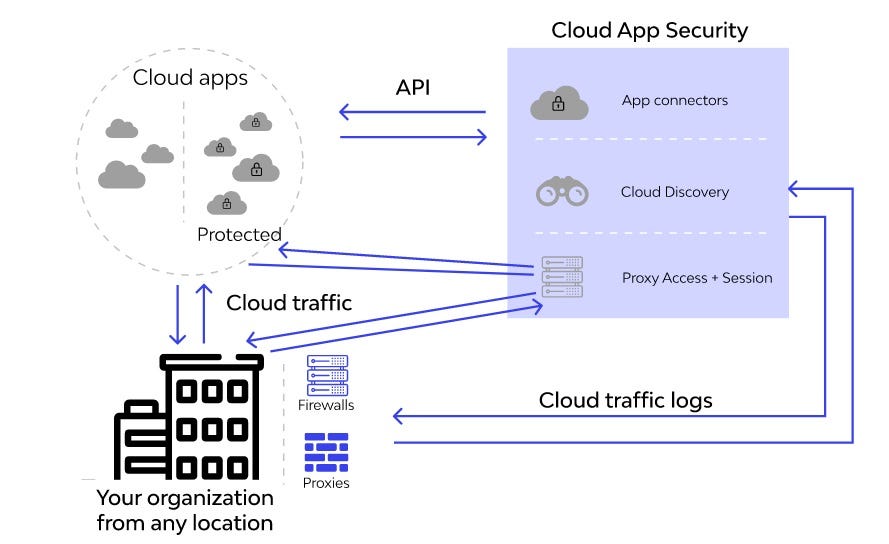
From a portability point of view, its crucial to have used security configurations to be highly portable so that they can be easily transported or extracted to any futuristic technology.
In a heterogeneous ecosystem, the API security-specific infrastructure across the API silos is used widely for defining the API security practices. The connection between API silos and API security infrastructure is configured as sidecars, sideband agents, and APIs embedded between cloud and on-premise deployments.
### Layers of API Security
API security is a diverse area with multiple layers. The focus of each layer is on specific API security and is designed to earn a specific and strong protection level.
**API Discovery**
The first layer of API security is dedicated to API discovery, as one cant save anything if there is no idea about the target or threat. There are a couple of obstacles that keep security operatives away from having full visibility of the used APIs. API silos, as quoted above, is the first obstacle, as it hampers the API visibility as it grants access to a partial API list.
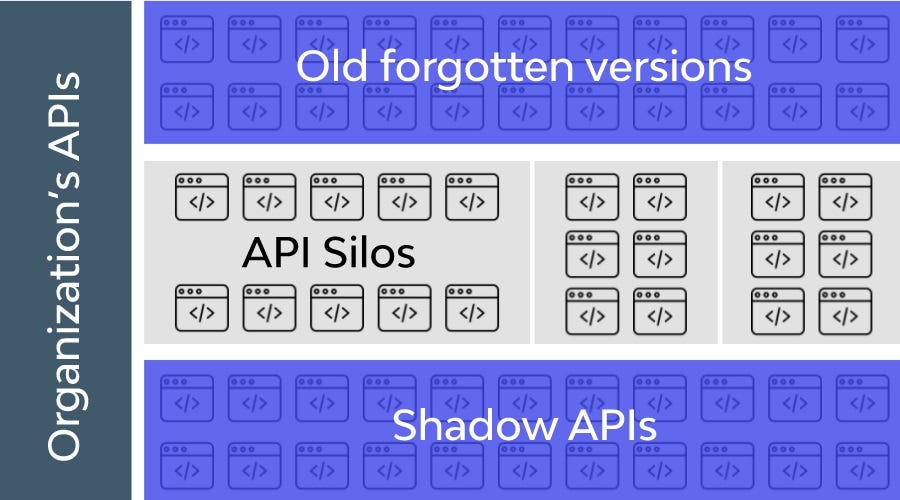
Rogue or shadow API is the second most hurdle in API visibility. It occurs when an API that is a part of the development and itself serves as application implementation. Shadow APIs happen when an API is developed as part of an application but the API itself is considered an implementation detail of the application and is only known by a close-knit group of developers. Shadow APIs are not on the radar of security operatives because they dont have visibility into the implementation details.
Finally, APIs go through their lifecycle. An API evolves, new versions of an API come up or an API may even be deprecated but continue to operate for a temporary period for backward compatibility and then be forgotten or gradually fall off the radar because they receive very little traffic.
API discovery is a race between API providers and hackers who will easily exploit the APIs when found. To discover your APIs before attackers do, you can mine your API traffic metadata. This data is extracted from API gateways, load balancers, or directly inline of network traffic and then fed to a specialized engine that reports on an effective list of APIs which can then be compared with catalogs of APIs that are available via an API management layer.
### API Security OWASP

**API1:2019 **[**Broken Object Level Authorization**]()
APIs will in general uncover endpoints that handle object identifiers, making a wide assault surface Level Access Control issue. Item level approval checks ought to be considered in each capacity that gets to an information source utilizing a contribution from the client.
**API2:2019 **[**Broken User Authentication**]()
Validation systems are frequently executed mistakenly, permitting assailants to think twice about tokens or to take advantage of execution defects to accept other clients characters for a brief time or for all time. Compromising a frameworks capacity to distinguish the customer/client, compromises API security generally speaking.
**API3:2019 **[**Excessive Data Exposure**]()
Anticipating nonexclusive executions, engineers will in general uncover all item properties disregarding their singular affectability, depending on customers to play out the information sifting prior to showing it to the client.
**API4:2019** [**Lack of Resources and Rate Limiting**]()
Frequently, APIs dont force any limitations on the size or number of assets that can be mentioned by the customer/client. Not exclusively would this be able to affect the API worker execution, prompting Denial of Service (DoS), yet additionally leaves the entryway open to verification imperfections like animal power.
**API5:2019 **[**Broken Function Level Authorization**]()
Complex access control strategies with various chains of command, gatherings, and jobs, and a hazy detachment among authoritative and ordinary capacities, will in general prompt approval blemishes. By taking advantage of these issues, assailants access other clients assets as well as regulatory capacities.
**API6:2019 **[**Mass Assignment**]()
RESTricting customer gave information (e.g., JSON) to information models, without legitimate properties sifting dependent on an allowlist, for the most part prompts Mass Assignment. Either speculating objects properties, investigating different API endpoints, perusing the documentation, or giving extra article properties in demand payloads, permits assailants to change object properties they shouldnt.
**API7:2019 **[**Security Misconfiguration**]()
Security misconfiguration is ordinarily an aftereffect of unstable default designs, fragmented or impromptu arrangements, open distributed storage, misconfigured HTTP headers, pointless HTTP techniques, lenient Cross-Origin asset sharing (CORS), and verbose mistake messages containing delicate data.
**API8:2019 **[**Injection**]()
Infusion blemishes, like SQL, NoSQL, Command Injection, and so forth, happen when untrusted information is shipped off a translator as a component of an order or question. The assailants noxious information can fool the translator into executing accidental orders or getting to information without appropriate approval.
**API9:2019 **[**Improper Assets Management**]()
APIs will in general uncover a larger number of endpoints than customary web applications, making appropriate and refreshed documentation exceptionally significant. Appropriate has and conveyed API forms stock additionally assume a significant part to relieve issues, for example, censured API forms and uncovered investigate endpoints.
**API10:2019 **[**Insufficient Logging and Monitoring**]()
Lacking logging and checking, combined with absent or inadequate incorporation with occurrence reaction, permits aggressors to additional assault frameworks, keep up with steadiness, turn to more frameworks to alter, remove, or annihilate information. Most break studies exhibit an opportunity to distinguish a break is more than 200 days, normally identified by outside parties instead of inward cycles or observing.
### For PenTest
Trying to [hack API with open source tools]()?
API Developers can think of using PenTest as this is the most widely used testing procedure. In the case of API PenTest, developers use Postman to proxy pre-built APIs. The pre-built API test data, created using Postman, will be swiftly used for pentesting, and reduces the testing cost while offering a detailed report.
Pentester can extract the proxy from the report and can perform multiple testing by communicating directly with the API.
**How can one be double sure that the organizations infrastructure is capable of bearing any sort of digital assault?**
PenTest, when done regularly and diligently, allows developers to find out the APIs protections level and contrive remedial solutions. As PenTest is a skilled task, its better to hire a skilled team or simulate API threats with open source tools. For more details, have a look at this guide.
### API Security Best Practices
API security is a non-negotiable aspect for data-centric projects and API development. Based upon the types of API implementation and various stages, the below-mentioned [API security best practices]() are widely used to keep diverse security risks at bay.
1. **Use of Encryption**
Encrypted APIs are hard to get attacked. APIs, used for internal and external communications, should be ciphered using the TLS encryption protocol. If possible, try to use encryption at both ends. Most TLS versions should be deployed.
**2. API Authentication**
API authentication is the easiest way to ensure that APIs are not exposed to strangers. Keep track of the resources that are calling the APIs, via API key or basic access authentication. This practice will increase the difficulty of the system and make it more secure.
**3. Make Most Of OAuth&OpenID Connect**
OAuth is a mechanism designed to prevent the need of remembering copious passwords. OAuth&OpenID Connect allows APIs to take the full responsibility of authorization and/or authentication.
Rather than generating different website-based accounts, OAuth allows you to connect via different credentials like Facebook or Google. In the case of APIs, it has the same sort of modus-operandi. API providers need to bank upon other third-party servers for API authorizations as API consumers, instead of offering their credentials, hand over the third-party granted token,
In this process of authorization, both the API consumers and API providers are not directly bearing the API authorization responsibility. Being a widely used delegation protocol, OAuth allows API providers to secret APIs a little further by adding the identity layer. That additional identity layer is known as the Open ID Connect standard that extends OAuth 2.0 with ID tokens.
**4. Security Experts**
With multiple API security practices, its natural to get confused and pick one. Hiring seasoned security experts that can guide you on using suitable Antivirus systems or ICAP servers will help you big time to enjoy robust API security.
**5. Continual Monitoring, Auditing, and Logging**
Prevention is better than cure. On the same note, its wise to keep track of the API interaction and spot the errors in the infancy stage. Audit and log relevant information on the server. These logs and records will be used later at the time of debugging. To keep track of API consumption, monitoring the dashboard is vital. When youre updating the versions, dont forget to add them to all the APIs.
**6. Share Limited Information**
The less information you share via APIs, the fewer would be API security risks. Try to display the least possible information in the error messages.
The content and email subjects of pre-defined messages that are not customized should be locked up as IP addresses can give away the location details.
Using IP Whitelist and IP Blacklist is a great way to keep the resource access limited. API resource access should be granted only to authorized professionals and all the crucial information, saved on interfaces, should be kept hidden.
**7. Throttling and Quotas For Protection**
To make sure the backend system bandwidth is as per the servers capability, throttle yourself and grant access to only a limited number of messages. Throttling and quotas are useful to keep the dangers like DDOS at bay.
**8. Valid Data**
Everything that the server is going to accept should be checked twice and validated. Any added content, data that is huge, and information shared by the consumer should be verified. JSON and XML validation are the two most widely used tools to find out whether or not the parameters are safe. They also keep SQL injection or XML bomb incidents under control.
**9. Robust Infrastructure**
Implementation of updated security networks and latest server and load balance software always keep API security tight and makes APIs strong enough to deal with data breaches.
**10. Pay Attention To OWASP Top 10**
In this list, the worst API vulnerabilities and their impacts are explained in detail. Experts suggest referring to this list and getting educated on the dangers that your API might encounter in the future. Alongside, securing all the OWASP vulnerabilities is also crucial
**11. Use API Firewalls**
Just as building a wall around our home keeps unwanted access controlled, building API firewalls ensures APIs have only allowed access. While youre firewalling the APIs, make sure two layers are added.
The first layer should be used to perform basic security checks like paying attention to the message size, the presence of SQL injections, and blocking the intruders instantly.
The second layer should be in LAN loaded with high-end security mechanisms.
**12. API Gateway Deployment**
APIs that are well managed are less prone to dangers. For effortless API management, we suggest using API Gateways as they allow you to control, monitor, and secure the API traffic from beginning to end.
### How to secure API and cloud-native apps
Use Wallarm a dependable and complete API security tool designed to safeguard websites, microservices, and APIs from all sorts of dangers including OWASP Top 10, bots, and application abuse easily.
The great part is Wallarms zero manual rule configuration and ultra-low false positives with Wallarm. Only reliable and real-time API security analysis and viable solutions will be offered. There is a free trial and demo offered for the convenience of the users. The tool is capable of protecting APIs of all sorts such as REST, SOAP, graphQL, gRPC.
Our seasoned [API security team]() is skilled enough to secure APIs in any sort of environment. We have mastered the art and science of API security in AWS, GCP, Azure and IBM Cloud ecosystem, regardless of the type of deployment.
_Originally published at _[_https://www.wallarm.com_]()_._
Read More

